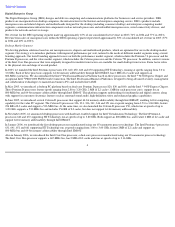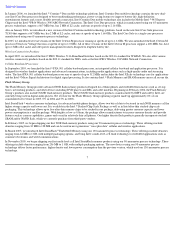Intel 2005 Annual Report Download - page 18
Download and view the complete annual report
Please find page 18 of the 2005 Intel annual report below. You can navigate through the pages in the report by either clicking on the pages listed below, or by using the keyword search tool below to find specific information within the annual report.
Table of Contents
Acquisitions and Strategic Investments
During 2005, we completed three acquisitions qualifying as business combinations in exchange for aggregate net cash consideration of $177 million,
plus certain liabilities. Also during 2005, we acquired a development-stage operation that resulted in the recording of workforce-in -place of
$20 million. An acquisition of a development-stage operation does not qualify as a business combination. During 2004, we completed one acquisition
qualifying as a business combination in exchange for net cash consideration of approximately $33 million, plus certain liabilities. In addition, we
entered into certain arrangements in 2004 related to the hiring of a group of employees that resulted in the recording of an intangible asset for
workforce-in -place of $28 million.
We make equity investments in companies around the world to further our strategic objectives and support our key business initiatives, including
investments through our Intel Capital program. We generally focus on investing in companies and initiatives to stimulate growth in the digital
economy, create new business opportunities for Intel and expand global markets for our products. The investments may support, among other things,
Intel product initiatives, emerging trends in the technology industry or worldwide Internet deployment. We invest in companies that develop software,
hardware or services supporting our technologies. Our current investment focus areas include helping to enable mobile wireless devices, advance the
digital home, enhance the digital enterprise, advance high-performance communications infrastructures and develop the next generation of silicon
production technologies. Our focus areas tend to develop and change over time due to rapid advancements in technology. Many of our investments are
in private companies, including development-stage companies with little or no revenue from current product offerings. In January 2006, Intel formed
IMFT, a NAND flash memory manufacturing company, with Micron. Intel invested $1.2 billion in return for 49% of the equity of IMFT. See
“Note 16: Venture” in Part II, Item 8 of this Form 10-K.
Intellectual Property and Licensing
Intellectual property rights that apply to our various products and services include patents, copyrights, trade secrets, trademarks and maskwork rights.
We maintain an active program to protect our investment in technology by attempting to ensure respect for our intellectual property rights. The extent
of the legal protection given to different types of intellectual property rights varies under different countries’ legal systems. We intend to license our
intellectual property rights where we can obtain adequate consideration. See “Competition” in Part I, Item 1 of this Form 10-K; “Legal Proceedings”
in Part I, Item 3 of this Form 10-K; and “Risk Factors” in Part I, Item 1A of this Form 10-K.
We have filed and obtained a number of patents in the U.S. and abroad. While our patents are an important element of our success, our business as a
whole is not materially dependent on any one patent. We and other companies in the computing, telecommunications and related high-technology
fields typically apply for and receive, in the aggregate, tens of thousands of overlapping patents annually in the U.S. and other countries. We believe
that the duration of the applicable patents we are granted is adequate relative to the expected lives of our products. Because of the fast pace of
innovation and product development, our products are often obsolete before the patents related to them expire, and sometimes are obsolete before the
patents related to them are even granted. As we expand our product offerings into new industries, such as consumer electronics, we also seek to extend
our patent development efforts to patent such product offerings. Established competitors in existing and new industries, as well as companies that
purchase and enforce patents and other intellectual property, may already have patents covering similar products. There is no assurance that we will be
able to obtain patents covering our own products, or that we will be able to obtain licenses from such companies on favorable terms or at all.
The large majority of the software we distribute, including software embedded in our component and system-level products, is entitled to copyright
protection. In most circumstances, we require our customers to enter into a software license before we provide them with that software.
To distinguish Intel products from our competitors’ products, we have obtained certain trademarks and trade names for our products, and we maintain
cooperative advertising programs with certain customers to promote our brands and identify products containing genuine Intel components.
We also protect certain details about our processes, products and strategies as trade secrets, keeping confidential the information that we believe
provides us with a competitive advantage. We have ongoing programs designed to maintain the confidentiality of such information.
14
























